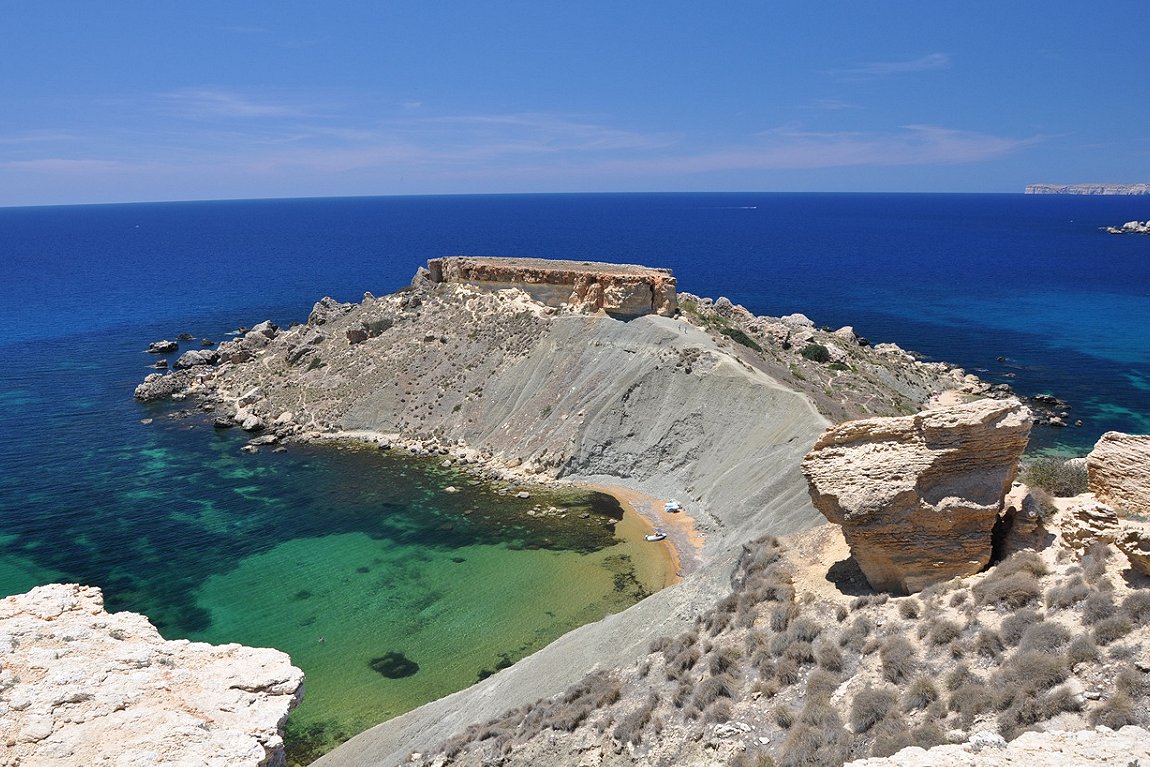 Cliffs at Gnejna Bay, Malta
Cliffs at Gnejna Bay, MaltaSource: https://commons.wikimedia.org/wiki/File:Gnejna_Bay_cliffs_eroding.jpg
Author: Robin & Bazylek

Malta is a small island nation in the Mediterranean Sea in Southern Europe. Covering just about 316 sq km (121 sq mi), Malta is one of the smallest and most densely populated countries in the world. It has a population of 413,000 (2011 estimate) of which 95.3% are ethnic Maltese. The official languages of Malta are Maltese and English. The de facto capital is Valletta while the largest town is Birkirkara.
Malta is a parliamentary republic headed by a president and a prime minister. It is in the Central European Time zone, which is an hour ahead of Coordinated Universal Time (UTC+1) and two hours in summer. The traffic is driven on the left, as in the United Kingdom. The electricity here is 230V/50Hz using UK plugs. The phone IDD code is +356. Malta uses the euro (EUR) as its official currency.
 Cliffs near Xlendi in Gozo, Malta
Cliffs near Xlendi in Gozo, MaltaSource: https://commons.wikimedia.org/wiki/File:Sudika_Xlendi_Cliffs.jpg
Author: Sudika

Malta had an estimated nominal GDP of $7.972 billion in 2010, equivalent to a per capita nominal GDP of $18,994. Its per capita GDP at purchasing power parity is $23,662.
Malta is an archipelago in the Mediterranean of which only the three largest islands are inhabited. These are known as Malta, Gozo and Comino. The islands of Malta are in fact the peak of submerged mountain range that was once a land bridge between Sicily and North Africa.
Malta experiences a subtropical Mediterranean climate. Its winters are mild while its summers are quite hot. The warmest month is August, when the average temperature may rise to 34°C (93°F). The coldest months are January and February, when temperature may drop to about 10°C (50°F). Nonetheless the capital of Malta, Valletta, has the warmest winters of any capitals of the Europe.
 Spire of St Paul's Anglican Cathedral and dome of the Carmelite Church of Our Lady of Mount Carmel in Valletta, Malta
Spire of St Paul's Anglican Cathedral and dome of the Carmelite Church of Our Lady of Mount Carmel in Valletta, MaltaSource: https://commons.wikimedia.org/wiki/File:St._Paul_and_Our_Lady_of_Mount_Carmel.jpg
Author: Robin & Bazylek

Archaeological evidence shows that the Maltese Islands have been inhabited by hunter-gatherers as early as 5,200 BC. The Ancient Greeks settled on Malta around 700BC. They were followed by the Phoenicians a century later. After the fall of Phoenicia in 400 BC, Malta was controlled by Carthage until the First Punic War in 264 BC, when it came under Roman control. When the Roman Empire split into the Eastern and Western divisions, Malta came under the control of the Eastern Division, which was the Greek-speaking Byzantine Empire, ruled from Constantinople.
In 1814, Malta became part of the British Empire through the Treaty of Paris. Its location half way between the Strait of Gibraltar and the Suez Canal was a great asset for the British. Malta received its independence from Britain on 21 September, 1964. Malta retained Queen Elizabeth II as Head of State until 1971, when it declared itself a republic within the Commonwealth, with a President as Head of State.
 Mgárr parish church, Malta
Mgárr parish church, MaltaSource: https://commons.wikimedia.org/wiki/File:Mgarr_Parish_Church.jpg
Author: Giorgio Parisotto

Malta joined the European union on 1 May, 2004. It became part of the Eurozone on 1 January, 2008. It began implementing the Schengen Agreement from 21 December, 2007.
Preparing Money for Malta
The currency used in Malta is the Euro (EUR).Planning your visit to Malta
As a member of the Schengen Agreement, Malta allows entry to visitors from EU and EFTA countries with just an approved ID card. It has no border controls with fellow EU members (except Bulgaria, Cyprus, Ireland, Romania and the United Kingdom) as well as with Iceland, Norway and Switzerland.Visitors of non-EU/EFTA countries who do not need a visa to enter Malta include the citizens of Albania, Andorra, Antigua and Barbuda, Argentina, Australia, Bahamas, Barbados, Bosnia and Herzegovina, Brazil, Brunei, Canada, Chile, Costa Rica, Croatia, El Salvador, Guatemala, Honduras, Hong Kong, Israel, Japan, Macau, Malaysia, Mauritius, Mexico, Monaco, New Zealand, Nicaragua, Panama, Paraguay, Saint Kitts and Nevis, San Marino, Seychelles, Singapore, South Korea, Taiwan, United States, Uruguay, Vatican City, and Venezuela.
Malta International Airport (MLA) is the only airport in Malta. It is the base of the national flag carrier, Air Malta, which flies to destinations in Europe, North Africa and the Middle East. The airport is also served by Ryanair which flies to a good number of destinations in Europe.
Major Cities in Malta
- Valletta - capital
- Birkirkara - biggest city
- Cottonera
- Marsaxlokk
- Mdina
- Mgarr
- Rabat
- St Julian's
- Sliema
- Victoria
Places of Interest in Malta
- Blue Grotto
- Clapham Junction
- Għajn Tuffieha
- Hagar Qim and Mnajdra
- Mellieħa
- St Thomas Bay
 Latest updates on Penang Travel Tips
Latest updates on Penang Travel Tips

Copyright © 2003-2025 Timothy Tye. All Rights Reserved.

 Go Back
Go Back